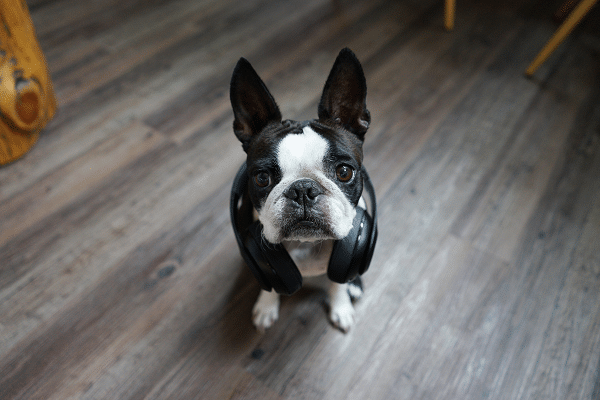The effect of music on dogs is a fascinating topic that has gained considerable attention in recent years. As pet owners, understanding how your furry friend perceives and reacts to music can help enhance their well-being and overall quality of life. This article delves into this intriguing topic, exploring how music therapy works, the science behind a dog’s hearing, and how different music genres can impact a dog’s behavior. It will also provide practical tips on using music therapy at home and highlight important considerations when using music therapy with dogs.
Contents
- 1 What Is Music Therapy?
- 2 Music Therapy For Animals
- 3 Understanding A Dog’s Hearing
- 4 The Effect Of Different Types Of Music On Dogs
- 5 Music’s Impact On Dogs’ Behavior
- 6 Music’s Impact On Dogs’ Stress And Anxiety
- 7 The Right Volume For Dogs
- 8 Practical Ways To Use Music Therapy For Your Dog
- 9 Cautions And Considerations
- 10 Be Mindful Of The Effect Of Music On Dogs!
What Is Music Therapy?

Music therapy is a well-established practice in human healthcare, leveraging the soothing power of melodies and rhythms to improve emotional, physiological, and neurological health. It is a non-invasive and enjoyable modality used to alleviate stress, improve mood, and even aid in the recovery of various medical conditions. For many people, it’s an integral part of their holistic wellness routine.
When it comes to animals, music therapy is still a relatively new concept. However, preliminary studies and anecdotal evidence have suggested promising results, inspiring pet owners and veterinarians alike to explore this area further. As it turns out, your canine companions might enjoy and benefit from a good tune as much as you do.
Music Therapy For Animals

Music therapy for animals stems from the idea that animals, like humans, can perceive and respond emotionally to music. Since the early 2000s, studies have started to investigate how different animals react to various types of music. The results have been compelling, with evidence of music having a positive effect on animal behavior and well-being.
The advent of music therapy for dogs, in particular, has been driven by these findings. A growing body of research suggests that certain types of music can significantly influence a dog’s mood and behavior. This has opened up a new and exciting avenue for pet care, enriching the understanding of pets and the innovative ways humans can enhance their lives.
Understanding A Dog’s Hearing

To understand the effect of music on dogs, it’s crucial to grasp how a dog’s auditory system works. Dogs have a more sensitive hearing range compared to humans, and they can hear frequencies that are well beyond your auditory capability. This superior hearing allows dogs to detect sounds you can’t and explains why certain noises might be more startling or intriguing to them than others.
However, this heightened sensitivity also means that dogs can be more vulnerable to noise-induced stress. Loud sounds or high-pitched frequencies, which you might find insignificant, can cause significant discomfort to dogs. This underscores the need to carefully consider your pets’ auditory environment and ensure that any exposure to music is done with their comfort and well-being in mind.
The Effect Of Different Types Of Music On Dogs

Research on the impact of different types of music on dogs has shown that genre matters. Classical music, for instance, has been observed to induce calm and relaxed behavior in dogs. In contrast, heavy metal music or loud, discordant sounds tend to increase stress levels, leading to restless and agitated behavior.
In one study, dogs in a shelter environment were exposed to different types of music. Those that listened to classical music showed signs of relaxation and spent more time resting, whereas dogs exposed to hard rock showed increased levels of agitation. These findings suggest that, much like humans, dogs respond differently to different types of music, and some genres may be more beneficial to their emotional state than others.
Music’s Impact On Dogs’ Behavior

Music can influence dogs’ behavior in various ways. Melodies and rhythms can act as a form of enrichment, providing mental stimulation and helping to alleviate boredom. In shelter environments, music has been used to create a more peaceful atmosphere, reducing barking and restlessness among the resident dogs.
Furthermore, music can be an effective tool for behavior modification. For instance, playing calming music during potentially stressful situations, like vet visits or thunderstorms, can help dogs stay relaxed and comfortable. This is because comforting melodies and rhythms can help distract dogs from their anxiety, promoting more positive associations with these situations.
Music’s Impact On Dogs’ Stress And Anxiety

Just as music can soothe a worried human mind, it can also help alleviate stress and anxiety in dogs. Soft, slow-tempo music, particularly classical music, has been shown to reduce cortisol levels in dogs—a hormone associated with stress. This can be particularly beneficial for dogs suffering from separation anxiety or fear of loud noises.
The effect of music on dogs with anxiety can be profound. Case studies have reported significant behavioral improvements in dogs when regularly exposed to calming music, demonstrating its potential as a non-invasive, drug-free approach to managing anxiety in dogs. The comforting, predictable rhythms of the music can provide a sense of security, making it an invaluable tool in the pet owner’s arsenal.
The Right Volume For Dogs

When playing music for dogs, the volume is an important factor to consider. Due to their more sensitive hearing, dogs are more susceptible to harm from loud sounds. Studies have found that dogs prefer music at a volume similar to their natural environmental sounds, which is usually quieter than the levels humans prefer.
To avoid causing discomfort or anxiety, it’s advisable to start at a low volume and gradually increase it, observing your dog’s behavior for any signs of distress. Remember, what may seem like a comfortable volume to you might be too loud for your pet. Always prioritize their comfort and safety when incorporating music into their routine.
Practical Ways To Use Music Therapy For Your Dog

Introducing music therapy to your dog is not as daunting as it may seem. You can start by playing soft, slow-tempo music during their rest time. Monitor your dog’s behavior for signs of relaxation, such as lying down, closing their eyes, or deep sighing.
If your dog shows signs of stress or discomfort, adjust the volume or try a different type of music. You can also use music strategically during potentially stressful situations, such as vet visits, car rides, or during a thunderstorm. Regularly incorporating music into your dog’s routine can significantly improve their quality of life, providing a soothing and enjoyable form of enrichment.
Cautions And Considerations

While music can be beneficial for dogs, it’s crucial to approach it thoughtfully. Each dog is unique, and what works for one might not work for another. Be observant and responsive to your dog’s behavior when introducing music therapy. If they seem distressed or uncomfortable, it may be best to try a different approach or consult with a professional.
Additionally, remember that music is not a cure-all. While it can provide comfort and enrichment, it should not replace veterinary care or appropriate training. Always consult your veterinarian or a behavioral expert if your dog is experiencing ongoing behavioral or health issues.
Be Mindful Of The Effect Of Music On Dogs!
The effect of music on dogs offers a fascinating insight into canine behavior and presents innovative possibilities for enhancing their well-being. By understanding their auditory capabilities and preferences, you can use music therapy to create a soothing, enjoyable environment for your pets. While it may require some experimentation and observation, the benefits of music therapy for dogs are worth exploring. This harmonious approach may just be music to your pet’s ears!


